Introduction
Budae Jjigae, often translated as “army base stew,” is a iconic Korean dish that blends post-war resourcefulness with bold, umami-rich flavors. Originating in the aftermath of the Korean War, this stew was born from necessity when locals combined scarce ingredients with processed foods from U.S. military bases, such as Spam, hot dogs, and canned beans. Over time, it evolved into a beloved comfort food celebrated for its ability to unite contrasting textures and tastes—sweet, salty, spicy, and savory—in a single simmering pot. While Budae Jjigae is traditionally served as a communal stew, this article focuses on its noodle-based adaptation: Budae Jjigae noodles, a hearty, one-pot meal perfect for cozy nights or feeding a crowd.
This recipe retains the dish’s signature elements—Spam, kimchi, instant noodles, and a rich, spicy broth—while offering flexibility for home cooks to customize based on pantry staples. Whether you’re a seasoned fan of Korean cuisine or a newcomer eager to explore its depths, this guide will walk you through creating an authentic, satisfying version of Budae Jjigae noodles at home.
The History and Cultural Significance of Budae Jjigae
To truly appreciate Budae Jjigae, one must understand its historical roots. In the 1950s, South Korea faced severe food shortages, and U.S. military bases provided rations like canned meats, cheese, and baked beans. Local communities, particularly in the city of Uijeongbu near Seoul, began incorporating these ingredients into traditional stews, creating a fusion dish that symbolized resilience and adaptability.
Today, Budae Jjigae is less about scarcity and more about indulgence. It’s a staple at pojangmacha (street food tents), jjimjilbang (saunas), and family dinner tables, often served bubbling hot with a side of steamed rice. The noodle version, while slightly non-traditional, reflects modern preferences for quicker, carb-heavy meals without sacrificing flavor.
Ingredients: Building Your Flavor Arsenal
The beauty of Budae Jjigae noodles lies in its adaptability. Below is a list of essential and optional ingredients, along with substitutions to suit dietary needs or pantry limitations.
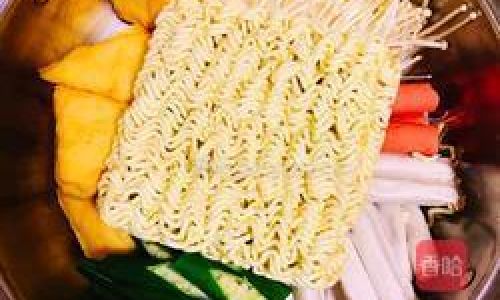
Proteins and Meats
- Spam (1 can, sliced): The star of the show, Spam adds saltiness and a meaty texture. Substitute with ham, bacon, or vegan alternatives like smoked tofu.
- Hot dogs (2–3, sliced diagonally): Choose beef, pork, or vegetarian options. For a gourmet twist, use kielbasa or chorizo.
- Korean fish cakes (eomuk, 1 cup sliced): These mild, chewy slices absorb broth flavors beautifully. Omit for vegetarian versions or substitute with fried fish balls.
- Shrimp or clams (1/2 lb, optional): Seafood adds brininess. Use fresh or frozen.
Vegetables and Aromatics
- Kimchi (1 cup, chopped): Opt for aged, fermented kimchi for deeper sourness.
- Onion (1 medium, sliced): Use yellow or white onions.
- Garlic (4 cloves, minced): Essential for aromatic depth.
- Green onions (1/2 bunch, chopped): Separate whites and greens for layered flavor.
- Mushrooms (1 cup sliced): Enoki, shiitake, or button mushrooms work well.
- Napa cabbage (2 cups, chopped): Adds sweetness and bulk. Substitute with bok choy or spinach.
Noodles and Broth Base
- Instant ramen noodles (3 packs, seasoning packets discarded): Use any brand; discard the flavor packets to control sodium.
- Anchovy broth (6 cups): Simmer 10 dried anchovies, a 3×3-inch piece of kombu, and 1/2 onion in water for 20 minutes. Substitute with chicken or vegetable broth.
- Gochujang (3 tbsp): Fermented chili paste for heat and depth.
- Gochugaru (2 tbsp): Korean red pepper flakes for vibrant color and spice.
- Soy sauce (2 tbsp): Use regular or low-sodium.
- Sugar (1 tsp): Balances acidity from kimchi and gochujang.
Optional Add-Ins
- American cheese (2 slices): Melts into the broth for creamy richness.
- Baked beans (1/2 cup): A nod to the dish’s origins.
- Ramen eggs (2, halved): Soft-boiled eggs marinated in soy sauce.
- Sesame oil (1 tsp): For fragrant finishing.
Equipment Checklist
- Large, heavy-bottomed pot or Dutch oven
- Cutting board and sharp knife
- Measuring spoons and cups
- Tongs or wooden spoon for stirring
- Ladle for serving
Step-by-Step Preparation
Prepping the Broth Base
Begin by crafting the anchovy-kombu broth, which forms the foundation of the stew’s umami. In a pot, combine 6 cups water, 10 dried anchovies (heads removed), a 3×3-inch piece of kombu, and 1/2 sliced onion. Bring to a simmer over medium heat, then reduce to low and cook for 20 minutes. Strain and discard solids. This broth can be made a day ahead and refrigerated.
Sautéing Aromatics and Proteins
Heat 1 tbsp vegetable oil in your pot over medium heat. Add sliced Spam and hot dogs, frying until lightly browned (3–4 minutes). Remove and set aside. In the same pot, sauté 1 sliced onion, 4 minced garlic cloves, and the white parts of the green onions until fragrant (2 minutes). Stir in 1 cup chopped kimchi and cook until slightly caramelized (3–4 minutes).
Building Layers of Flavor
Add the anchovy broth to the pot, followed by 3 tbsp gochujang, 2 tbsp gochugaru, 2 tbsp soy sauce, and 1 tsp sugar. Stir until dissolved. Layer in the fried Spam, hot dogs, 1 cup sliced mushrooms, and 2 cups napa cabbage. Bring to a gentle simmer.
Introducing the Noodles
Break the instant ramen blocks into the pot, submerging them in the broth. Cook for 3–4 minutes until noodles soften. Gently stir to prevent sticking.
Final Touches and Garnishes
Add 1 cup sliced Korean fish cakes and 1/2 lb shrimp (if using). Simmer for 2–3 minutes until shrimp turn pink. Optional: Lay 2 slices of American cheese over the surface to melt into the broth.
Serving Ritual
Transfer the steaming pot to the table, garnished with the reserved green onion tops, sesame seeds, and a drizzle of sesame oil. Serve with sides like steamed rice, pickled radish, and extra kimchi. Encourage diners to slurp noodles directly from the pot or ladle portions into bowls.
Customization and Variations
Vegetarian/Vegan Budae Jjigae Noodles
- Replace Spam and hot dogs with store-bought vegan alternatives or homemade seitan.
- Use vegetable broth and omit fish cakes.
- Add extra vegetables like zucchini, carrots, or sweet potato noodles.
Spice Level Adjustments
- Reduce gochugaru to 1 tbsp for mild heat.
- Add fresh chili peppers or sriracha for extra kick.
Protein Swaps
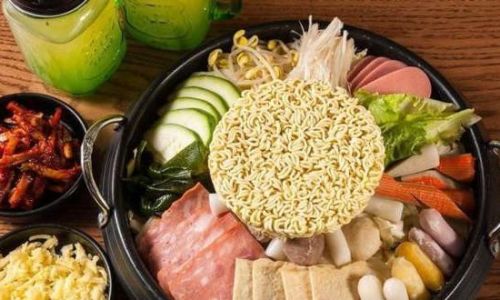
- Tofu: Press firm tofu, cube, and pan-fry until golden before adding.
- Chicken: Use shredded rotisserie chicken or thinly sliced breast.
Regional Twists
- Cheese Budae Jjigae: Popular in Busan, this version piles on mozzarella or cheddar.
- Seafood Budae Jjigae: Focus on clams, mussels, and squid.
Troubleshooting Common Issues
Q: My broth is too salty!
A: Dilute with water or unsalted broth. Add a potato chunk to absorb excess salt (remove before serving).
Q: The noodles are mushy.
A: Cook noodles separately and add them just before serving next time.
Q: The stew lacks depth.
A: Boost umami with a splash of fish sauce or a teaspoon of miso paste.
Leftovers and Storage
Budae Jjigae noodles reheat beautifully. Store in an airtight container for up to 3 days. Reheat gently on the stove, adding a splash of water if the broth thickens. Freeze portions for up to a month; thaw overnight in the refrigerator.
The Cultural Experience of Eating Budae Jjigae
In Korea, sharing Budae Jjigae is a communal act. The steaming pot is placed in the center of the table, and diners help themselves, adjusting flavors with extra kimchi, sesame oil, or rice. The dish’s chaotic mix of ingredients mirrors its history—a testament to survival and innovation.
Conclusion
Budae Jjigae noodles are more than a meal; they’re a culinary time machine, transporting diners to a era of resilience and creativity. Whether you’re a purist sticking to tradition or a home cook experimenting with substitutions, this recipe offers a gateway to Korean comfort food. Gather your ingredients, invite loved ones, and let the sizzle of the pot tell its story.
FAQs
Can I use fresh noodles instead of instant ramen?
Yes! Substitute with udon, sweet potato noodles, or fresh ramen. Adjust cooking time accordingly.
Is Budae Jjigae very spicy?
The spice level is adjustable. Start with the recommended amounts and add more gochugaru or chili flakes to taste.
Can I make this gluten-free?
Use tamari instead of soy sauce and verify that your instant noodles are gluten-free. Spam contains wheat, so opt for gluten-free alternatives.
What drinks pair well with this dish?
Korean soju, cass beer, or citrusy tea like yuzu-cha complement the stew’s richness.
Can I prepare components ahead of time?
Absolutely! Chop vegetables, slice meats, and make the broth in advance. Assemble and cook just before serving.
Embark on your Budae Jjigae noodles adventure, and let the fusion of flavors and textures delight your senses. This dish isn’t just food—it’s a celebration of history, adaptability, and the joy of sharing a meal. 🍜

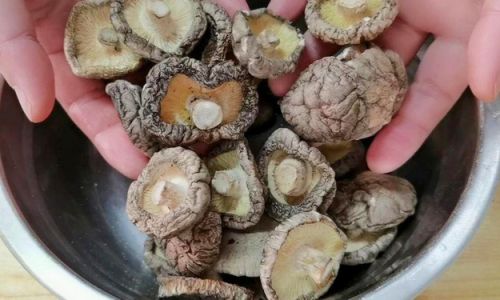
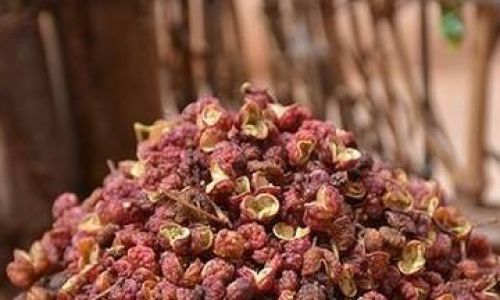
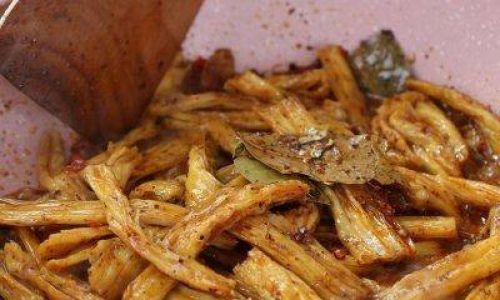

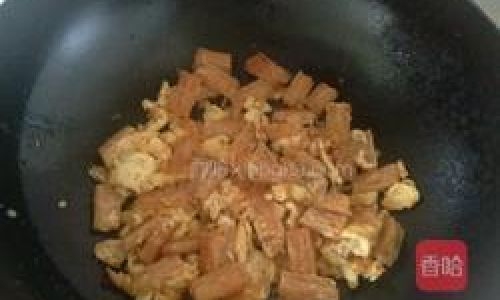
0 comments